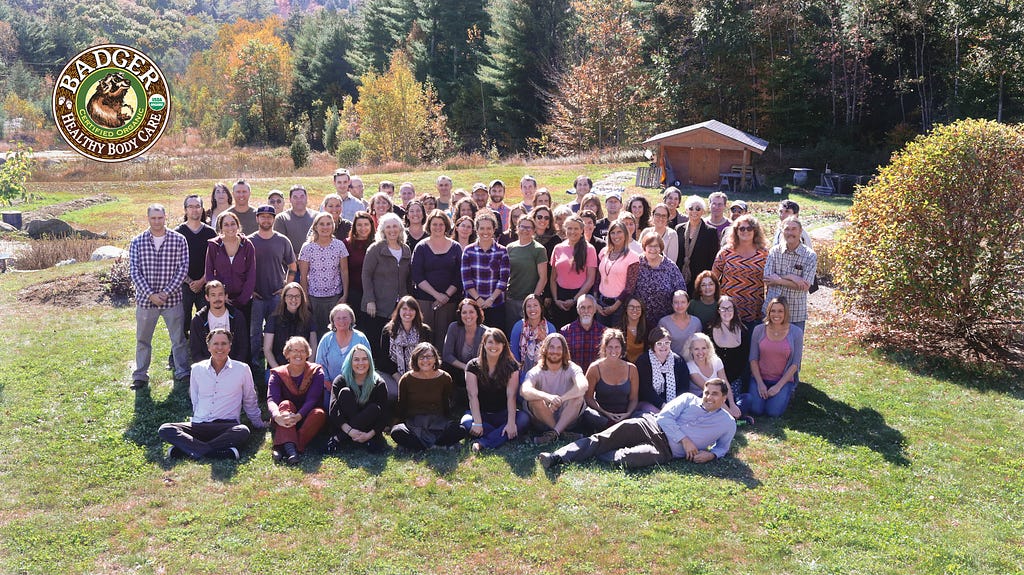Company Growth Creates Leadership Challenges and Opportunities for B Corp Badger

By Justin Wright and Lucas Freeman of Habitus Incorporated and Emily Hall Warren of W.S. Badger Company
When your company grows, your culture grows with it. And one of the most crucial elements of culture is the way decisions are made — especially in a mission-driven organization, where buy-in and alignment are crucial to success. Do employees and owners alike feel heard, or are silos and resentment fragmenting the team?
Growth and unity can go hand in hand. The evolution of W.S. Badger Company—aka Badger, a well-known company in the natural personal care products market—provides a shining example of how this works.
This article, a collaboration between Certified B Corporations Habitus and Badger, summarizes the phases of Badger’s evolution from the standpoint of leadership and strategic planning and outlines how the company built a leadership culture around consensus. The results are inspiring: Mission alignment has improved, the decision-making culture has matured, company leaders are better able to balance decision quality and efficiency as needed, and an appetite to innovate with their decision-making process remains.
The Evolution of Decision Making at Badger
Stage 1: Founding — 25 employees
Early on, co-founder and CEO Bill Whyte was the original decision-making authority. From the outset, he and Katie Schwerin (Bill’s spouse and Badger co-founder) solicited input and feedback from employees through monthly meetings and a yearly retreat, and by fostering a general culture of idea sharing.
But neither Katie (formerly a nonprofit facilitator and a teacher) nor Bill (a carpenter and inventor of the original Badger Balm) were trained in business administration. This wasn’t a glaring problem in the early days as the company grew because everybody was within arm’s reach and changes and surprises could be addressed with relative ease.
Still, to enjoy and thrive in that environment, employees had to learn to adapt to a certain level of unpredictability and lively chaos (for example, on a particularly hot day, Bill might decide to shut down the business and encourage everyone to go for a swim in the river). They also learned to embrace flash decisions that might overturn work in progress (for example, Marketing might be working on a cover drawing for promotional material, and Bill would arrive unexpectedly with a different illustration he had worked up the night before).
Stage 2: Growth from 25–50 employees
As the company grew, and the leadership team grew along with it, the lack of clarity around the decision-making process resulted in ambient anxiety, periodic dips in morale, and increased tension on the family leadership team. Bill and Katie’s daughters, Emily and Rebecca, were becoming more involved in the company as high-level decision makers but without clear decision-making parameters. Employees weren’t always sure who the point person was for their area, and this confusion led, at times, to tension and frustration within the family leadership team and between employees and leadership.
Confusion over the decision-making process was compounded by the differing leadership styles natural to each of the family-owners (Emily: speedy results oriented; Rebecca: survey all options to uncover maximum value; Katie: bringing everyone up together, one step at a time; Bill: relaxing in a hammock until inspiration strikes). Their differing talents and approaches as leaders didn’t effortlessly gel, and the conflict that would sometimes arise between them was the result of a perfect storm of family dynamics mixed with clashes of personality that played out on a landscape of unclear decision authority.
In other words, the family was failing to coordinate the individual strengths of its leaders strategically. The need for some fundamental shifts became clear as the company approached 50 employees. To maintain a fun, healthy work environment, the question became: How best to go about this kind of transformation?
Stage 3: Growth from 50–100 employees (present day)
The family decided to consult a relationships systems coach (Maddie Weinreich of CRR Global) to help them express and explore their leadership styles. After four sessions of reflective group inquiry, they were able to see at a much higher resolution how each person approached problem-solving and organizing. This was instrumental in helping them better understand one another as leadership collaborators, but also to better define respective areas of authority in the company. For instance, rather than dividing Marketing (under Katie) and Sales (under Emily), they were combined under Emily because she was capable and interested in managing both and because coordinating across these two areas had created conflict between Katie and Emily in the past.
They also decided to create a strategic team that included perspectives beyond the family four. This helped diffuse the creep of family dynamics into company-wide decision making and elevate area-specific concerns. The strategic team was an excellent vehicle for conveying information companywide and strengthening mission alignment. Also, the added voices and perspectives usually provided needed pushback to big-vision planning (e.g., practical constraints coming from operations, finance, and administration).
Until this point, Katie had been managing the substance of her areas of responsibility and facilitating the meetings among family members. Playing the role of facilitator and COO simultaneously made it hard for Katie to do either as well as she wanted to, so the family brought Emily Hall Warren — whom they had hired as director of administration, in part because of her skills and experience with facilitation — onto the strategic team with the exclusive role of facilitator. The team expanded to include the director of sales, director of operations and strategic financial director, who each brought unique perspectives and contributions.
Ingredients for Success
Badger’s strategic team is an essential element of the company’s ongoing success, one that has ripple effects that spread well beyond team meetings. Habitus identified four factors contributing to this success. The first three are basic must-haves for any organization looking to implement this kind of collaborative model. The fourth is essentially a desirable byproduct of doing the first three really well.
1. Establishing clear areas of leadership.
Defining and assigning areas of management and authority has dramatically reduced the number of grey-zone conflicts among company leadership and clarified for area employees who their relevant decision maker is.
2. Maintaining clear decision-making authority.
The vast majority of company-wide decisions at Badger are made by the strategic team because it is an effective decision-making venue and produces high levels of buy-in. It is important to note, however, that the strategic team is a model for information and priority sharing across company areas and for collaborative problem-solving. Company authority still rests with the family four leadership as a kind of fail-safe or backstop to the strategic team and individual area teams. Certain decisions are more appropriately made by the owners, for instance, splitting the CEO role in two or reformulating the company’s broader mission commitments.
3. Having careful, committed facilitation.
Before coming to Badger, Hall Warren had professional training and experience in facilitating meetings. Having one person whose primary responsibility is to be in charge of the process allows others to focus on the substance of the conversation without having to worry about the integrity of the process itself.
However, assigning a dedicated facilitator to the process is only half of the recipe. As a general rule, the amount of skill and effort demanded of a facilitator in these kinds of decision-making settings depends on the group’s makeup and dynamic. Badger’s strategic team identified four factors that helped ease Hall Warren’s role and spread the facilitation effort across the team:
Trust and strength of relationships. The strategic team emerged out of a process of the leaders learning to see and trust in the strengths of their co-leaders. The first non-family members invited to the team all had long-term working relationships (in some cases, close personal relationships) with the family. High levels of trust and mutual respect produced a context strong enough to endure the intense debate and disagreements that occasionally emerge in a consensus-based process. As Hall Warren mentioned says, the fact that she is now so familiar with the personalities of each team member allows her to “read” the process much better. For instance, she will notice that doubts on an issue may still be lingering on a vote that passes or that a particular issue will trigger higher emotions in certain members.
A culture of radical candor. Sitting in on one of Badger’s meetings, what stands out is the amount of humor and laughter. This made the meeting more fun but also created a space where it was safe for members to be honest and direct with one another. This has contributed to a culture of “calling it as you see it” that allows the team to better confront what is actually going on in the room.
Manageable team size. Eight people is enough to allow for diversity of opinion without becoming overwhelming. Several team members voiced to us their skepticism around how much larger the team should/could grow. Onboarding new people can be an adjustment because of the delicate balance of personalities and the need to weigh democracy and group consensus against decision-making efficacy.
Regularity. While the meetings don’t always run two hours (90 minutes was generally agreed on as an ideal meeting length), a two-hour time slot held every week helps everybody prioritize these sessions.
4. Sliding levels of formality.
The team started with a meeting process that was formal and, at times of high conflict, that level of formality is still useful. But for most discussions, a much less formal execution of the process suffices. Over time, the group members have developed a feel for how formal they need the process to be depending on how serious the issue is on the table. The less formal the process is, the easier and more efficient it is for all involved. This flexibility and sliding level of formality are the marks of a mature team dynamic, wherein members trust each other and are candid with one another and committed to collaboration. Without it, commitment to a consensus-focused process can easily wane because it ends up feeling too rote and burdensome.
Hall Warren told us that, as the facilitator, she is always conscious of balancing the benefit of meeting efficiency with the need for decision quality. When an issue is so important that everyone needs to be 100% onboard, the level of formality is high. When the room is emotionally charged, the level of formality is high, because it ensures that everyone has a chance to be properly heard. It is unwise to risk relationship damage by pushing through a decision that doesn’t sit well with one or two members of the group, thereby lowering the quality of the decision. From the facilitation point of view, the goal is not to lower the level of formality — loose informality is not an end in itself. Rather, the goal is to be a good judge of when to execute the proceedings more formally, and when to loosen the grip.
For details on Badger’s strategic team meeting process and proposals for how the company might expand its decision-making model, see the longer version of this study.
B the Change gathers and shares the voices from within the movement of people using business as a force for good and the community of Certified B Corporations. The opinions expressed do not necessarily reflect those of the nonprofit B Lab.

Can Consensus Decision-Making Work in Business? was originally published in B the Change on Medium, where people are continuing the conversation by highlighting and responding to this story.